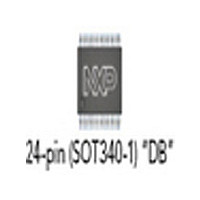TEA1095TS NXP Semiconductors, TEA1095TS Datasheet - Page 11

TEA1095TS
Manufacturer Part Number
TEA1095TS
Description
Manufacturer
NXP Semiconductors
Datasheet
1.TEA1095TS.pdf
(28 pages)
Specifications of TEA1095TS
Operating Temp Range
-25C to 75C
Package Type
SSOP
Pin Count
24
Operating Temperature Classification
Commercial
Mounting
Surface Mount
Lead Free Status / Rohs Status
Compliant
Available stocks
Company
Part Number
Manufacturer
Quantity
Price
Part Number:
TEA1095TS
Manufacturer:
PHILIPS/飞利浦
Quantity:
20 000
Philips Semiconductors
D
The TEA1095 selects its mode of operation (transmit,
receive or idle mode) by comparing the signal and the
noise envelopes of both channels. This is executed by the
decision logic. The resulting voltage on pin SWT is the
input for the voice-switch.
To facilitate the distinction between signal and noise, the
signal is considered as speech when its envelope is more
than 4.3 dB above the noise envelope. At room
temperature, this is equal to a voltage difference
V
is implemented in both channels.
The signal on TXIN contains both speech and the signal
coming from the loudspeaker (acoustic coupling). When
receiving, the contribution from the loudspeaker overrules
the speech. As a result, the signal envelope on TENV is
formed mainly by the loudspeaker signal. To correct this,
an attenuator is connected between TENV and the
TENV/RENV comparator. Its attenuation equals that
applied to the transmit amplifier.
When a dial tone is present on the line, without monitoring,
the tone would be recognized as noise because it is a
signal with a constant amplitude. This would cause the
TEA1095 to go into the idle mode and the user of the set
would hear the dial tone fade away. To prevent this, a dial
tone detector is incorporated which, in standard
application, does not consider the input signals at RXIN as
noise when they have a level greater than 42 mV (RMS).
This level is proportional to R
As can be seen from Fig.8, the output of the decision logic
is a current source. The logic table gives the relationship
between the inputs and the value of the current source. It
can charge or discharge the capacitor C
of 10 A (switch-over). If the current is zero, the voltage on
SWT becomes equal to the voltage on IDT via the high
ohmic resistor R
difference between SWT and IDT determines the mode of
the TEA1095 and can vary between 400 mV and
+400 mV.
Table 1 Modes of TEA1095
1997 Nov 25
< 180
0
>180
ENV NOI
ECISION LOGIC
Voice switched speakerphone IC
V
SWT
= 13 mV. This so called speech/noise threshold
V
IDT
:
IDT
(mV)
PINS
(idling). The resulting voltage
IDT
AND
transmit mode
idle mode
receive mode
RSEN
SWT
.
MODE
SWT
with a current
11
The switch-over timing can be set with C
timing with C
Fig.12, C
This enables a switch-over time from transmit to receive
mode or vice-versa of approximately 13 ms (580 mV
swing on SWT). The switch-over time from idle mode to
transmit mode or receive mode is approximately 4 ms
(180 mV swing on SWT).
The switch-over time from receive mode or transmit mode
to idle mode is equal to 4
approximately 2 s (idle mode time).
The inputs MUTETX and MUTERX overrule the decision
logic. When MUTETX goes HIGH, the capacitor C
charged with 10 A resulting in the receive mode. When
the voltage on pin MUTERX goes HIGH, the capacitor
C
mode.
V
A diagram of the voice-switch is illustrated in Fig.9. With
the voltage on SWT, the TEA1095 voice-switch regulates
the gains of the transmit and the receive channel such that
the sum of both is kept constant.
In the transmit mode, the gain of the transmit amplifier is at
its maximum and the gain of the receive amplifier is at its
minimum. In the receive mode, the opposite applies. In the
idle mode, both transmit and receive amplifier gains are
halfway.
The difference between maximum and minimum is the so
called switching range. This range is determined by the
ratio of R
0 and 52 dB. R
an internally used reference current. In the basic
application diagram given in Fig.12, R
365 k which results in a switching range of 40 dB. The
switch-over behaviour is illustrated in Fig.10.
In the receive mode, the gain of the receive amplifier can
be reduced using the volume control. Since the
voice-switch keeps the sum of the gains constant, the gain
of the transmit amplifier is increased at the same time (see
dashed curves in Fig.10). In the transmit mode however,
the volume control has no influence on the gain of the
transmit amplifier or the gain of the receive amplifier.
Consequently, the switching range is reduced when the
volume is reduced. At maximum reduction of volume, the
switching range becomes 0 dB.
OICE
SWT
-
is discharged with 10 A resulting in the transmit
SWITCH
SWT
SWR
SWT
is chosen at 220 nF and R
:
and R
PINS
STAB
and R
STAB
STAB
should be equal to 3.65 k and sets
IDT
and is adjustable between
. In the basic application given in
AND
R
IDT
SWR
C
SWT
Product specification
SWR
and is
SWT
IDT
TEA1095
is equal to
, the idle mode
at 2.2 M .
SWT
is
















